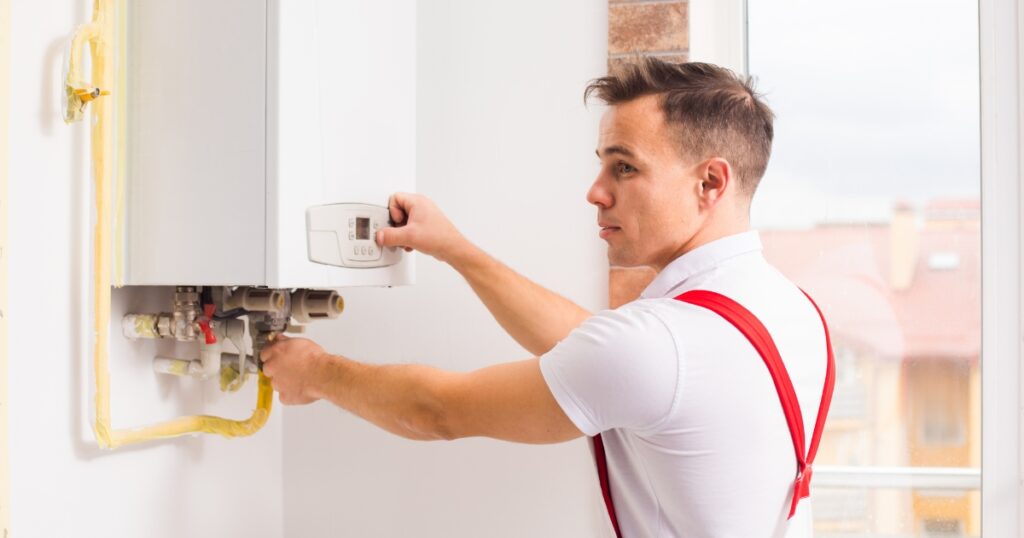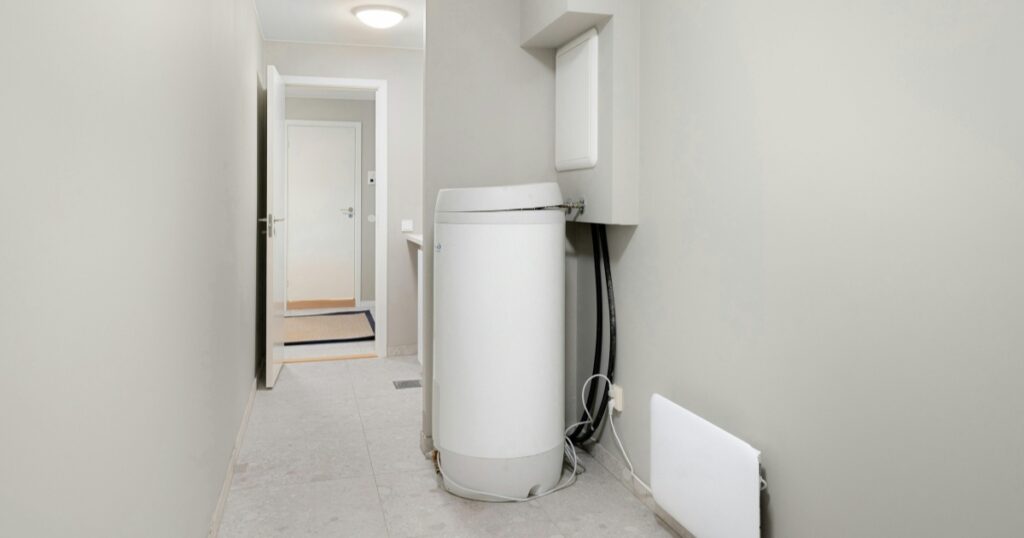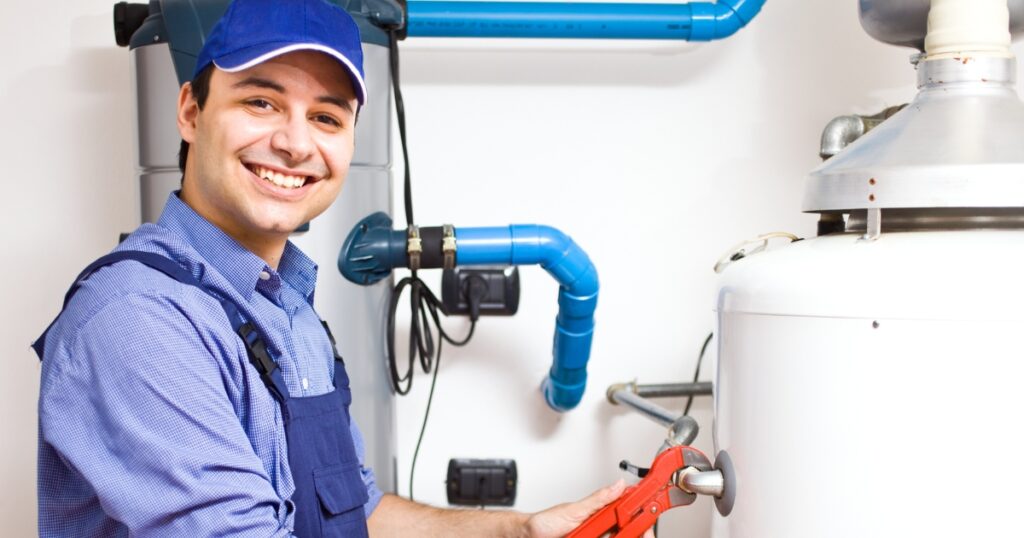Ah, the dreaded cold shower with nothing but a feeble dribble that fancies itself as hot water! Mate, we understand how maddening it is to be longing for a scorching bath only to be let down.
We’ve taken the liberty of plumbing the depths to suss out some straightforward fixes so you can sort out those infuriating hot water hiccups. No need to put up with another disappointing trickle; we’re here to help boost your hot water pressure problem and get your showers back to being bonza!
Key Takeaways
- Sediment and scale buildup can clog your hot water pressure problems, causing low pressure. Regular flushing of the tank helps prevent this issue.
- Blocked pipes, faulty fixtures like worn-out taps, and leaks in the system are common culprits in reducing hot water pressure.
- Filters should be cleaned or replaced regularly as part of routine maintenance to ensure optimal performance of your hot water system.
- Check valve settings such as tempering valves and pressure-reducing valves; incorrect settings can lead to inconsistent temperatures and low pressure.
- Repair any identified leaks promptly to avoid further damage to your plumbing system; even small drips can affect overall water pressure.
Causes of Low Hot Water Pressure
– Accumulation of sediment and scale can restrict the flow of hot water through the pipes. Blocked or clogged pipes can also impede the water flow, as well as faulty fixtures and leaks in the system.
Accumulation of sediment and scale
Over time, our hot water systems can get clogged with sediment and scale, particularly if we’re using hard water. This build-up is a stealthy culprit that gradually reduces the flow of hot water through the pipes until one day we realise our showers are more a trickle than a torrent.

It’s like cholesterol in arteries; these deposits narrow the passage inside pipes and heaters, making it tough for hot water to come through at full blast.
We should regularly flush out our hot water tank to prevent this from happening. If we’ve been neglecting this maintenance task, there’s no need to worry – it can be done without too much hassle.
Flushing clears out sediments that have settled on the bottom of the tank, restoring proper function and allowing us to enjoy powerful showers once again. Next up: Blocked pipes could also be causing grief with your home’s water pressure.
Let’s dive into how they throw a spanner in the works and what we can do about it.
Blocked pipes
If you’ve checked for sediment and scale buildup in your hot water system and still experiencing low pressure, blocked pipes could be the culprit. Debris, dirt, or mineral deposits can restrict the flow of water through the pipes, resulting in decreased hot water pressure.
When this happens, it’s essential to address the issue promptly to restore optimal flow throughout your plumbing system.
To fix blocked pipes causing low hot water pressure, consider using specific pipe-cleaning products designed to dissolve any obstructions without damaging the piping system. Alternatively, consulting a professional plumber may be necessary for more severe blockages or if you’re unsure about handling chemical cleaners on your own.
Faulty fixtures
Faulty fixtures, such as worn-out taps or leaky pipes, can significantly contribute to low hot water pressure in your home. It’s essential to regularly check for any signs of wear and tear on your fixtures and address them promptly.
Worn-out tap washers are a common culprit for low hot water pressure and require simple replacements or complete updates. Additionally, addressing any leaks from faulty fixtures is crucial to maintaining optimal hot water pressure throughout your home.
Ensuring that faulty fixtures are promptly fixed will help maintain consistent hot water pressure in your home. Leaking taps and pipes should be addressed immediately to avoid further damage to your plumbing system.
Leaks
If you notice a drop in your hot water pressure, leaks could be the culprit. One of the common causes is leaking pipes, which can lead to a significant loss of water pressure. It’s essential to inspect all visible pipes for any signs of leakage or corrosion.
Additionally, don’t forget to check around fixtures and taps for any dripping or pooling water as this might indicate a leak that is affecting your hot water pressure.
Repairing leaks promptly can help restore your hot water pressure and prevent further damage to your plumbing system. Identifying and fixing these leaks early on can save you from potential larger problems down the line.

Common Causes of Low Hot Water Pressure Problems
Worn-out or faulty taps, sediment and debris buildup, inadequate plumbing, valve issues, and filter problems are some common causes of low hot water pressure. Click here to learn more about diagnosing and fixing hot water pressure problems.
Worn-out or faulty taps
Old or faulty taps are a common culprit for low hot water pressure. When tap washers wear out, they can cause leaks and reduce the flow of hot water. This problem often requires replacing the tap washers or updating with complete tap replacement to restore proper water pressure.
Additionally, addressing worn-out or faulty taps is a simple fix that can significantly improve your hot water system’s performance.
If you’re experiencing low hot water pressure, it’s essential to check the condition of your taps and consider this as one of the potential causes. Ensuring that your taps are in good working condition will help maintain adequate hot water pressure throughout your home.
Sediment and debris buildup
Sediment and debris buildup in hot water systems can lead to low water pressure. Over time, minerals and other particles settle at the bottom of the hot water tank or build up in pipes, restricting the flow of water.
This buildup may result in decreased hot water pressure at taps and fixtures throughout your home. Addressing sediment and debris accumulation involves flushing out the tank and cleaning or replacing filters to ensure unobstructed water flow.
To mitigate sediment buildup, it’s essential to flush your hot water system periodically according to manufacturer recommendations. Additionally, installing a whole-house filter can help trap sediments before they enter your plumbing system.
Keeping an eye on sediment levels and promptly addressing any accumulation is critical for maintaining optimal hot water pressure.
Inadequate plumbing
When sediment and debris buildup causes low hot water pressure, inadequate plumbing could be the root cause of the issue. Dodgy plumbing work can lead to restricted water flow throughout your system.
If your home has outdated or incorrectly sized pipes, fittings, or connections, it can hinder the optimal distribution of hot water. Furthermore, improper installation of your hot water tank or poor maintenance practices in the past may also contribute to reduced pressure.
While low hot water pressure is undoubtedly frustrating, understanding potential issues with your plumbing system can help you address the problem effectively. Checking for any signs of inadequate plumbing such as corroded pipes, improperly installed valves, or faulty pipe joints will be beneficial in identifying and remedying this concern.
Valve issues
Check your hot water system for valve issues. Faulty tempering valves or pressure-reducing valves can cause low hot water pressure. If these valves are not functioning properly, they may need to be repaired or replaced by a professional plumber to restore the appropriate flow of hot water.
A malfunctioning valve can result in inconsistent temperatures and inadequate pressure, affecting the overall performance of your hot water system.
Understanding and addressing valve issues is crucial for maintaining proper hot water pressure throughout your home. By ensuring that all valves are working correctly, you can prevent potential problems and enjoy a reliable supply of hot water for your daily needs.
Filter problems
If you’ve checked your hot water system for valve issues and suspect filter problems, it’s essential to address this promptly. Clogged filters can restrict the flow of hot water, leading to low pressure in your taps and shower.
Sediment buildup is a common culprit for filter issues in hot water systems. By regularly cleaning or replacing the filters, you can ensure that your hot water flows freely and at the right pressure throughout your home.
Ignoring filter problems could lead to reduced efficiency in your hot water system and potentially costly repairs down the line. It’s important to keep an eye on these components and address any sediment buildup promptly to maintain optimal hot water pressure in your household.
How to Diagnose Low Hot Water Pressure
To diagnose low hot water pressure, check for leaks, inspect fixtures and taps, look for sediment buildup, and confirm correct valve and filter settings. Curious to learn more? Keep reading!
Check for leaks
We need to ensure there are no leaks in the hot water system. Simply inspect your hot water tank, pipes, and fittings for any signs of leakage such as wet spots or dripping water.
A leak can cause low hot water pressure by reducing the volume of hot water reaching your taps. Addressing any leaks will help to improve your hot water pressure.
After checking for leaks, it’s important to also inspect fixtures and taps for issues that might be contributing to low hot water pressure.
Inspect fixtures and taps
Inspect all fixtures and taps for signs of wear and tear. Look for any visible leaks or corrosion, which could be contributing to the low hot water pressure. Consider replacing worn-out tap washers or updating with new fixtures if necessary.
This simple fix can often resolve low hot water pressure issues caused by faulty taps.
Examine the fixtures and taps closely to identify any sediment or debris buildup that may be obstructing the flow of hot water. Sometimes, a thorough cleaning can alleviate this issue without requiring replacement.
If sediment is present, consider cleaning or replacing the affected fixtures to restore proper water pressure.
Check for sediment buildup
Inspect the hot water system for sediment buildup, which can obstruct the flow of hot water and lead to low pressure. Sediment often settles at the bottom of the tank or accumulates in pipes over time.
Unclogging any sediment deposits and cleaning out the system will help restore proper hot water pressure.
To effectively diagnose sediment buildup issues, start by checking for signs such as discoloured water or reduced flow from fixtures. If you notice these indicators, it’s crucial to take action promptly to prevent further blockage and potential damage to your hot water system.
Confirm the correct valve and filter settings
Check the valve and filter settings to ensure they are correctly adjusted for optimal hot water pressure. Properly set valves and filters can significantly impact the flow of hot water throughout your home.
If these settings are not at their optimal levels, it could result in reduced pressure and potentially lead to further issues down the line. By confirming that your valve and filter settings are correct, you can help maintain steady and adequate hot water pressure in your household plumbing system.
Ensuring that the valve is open to an appropriate level and that filters are clean will contribute to consistent hot water pressure at all fixtures. Neglecting these essential components may affect the overall performance of your hot water system, so regular checks on valve and filter settings should be part of routine maintenance.
Ways to Fix Low Hot Water Pressure
To fix low hot water pressure, we can start by unclogging pipes and replacing worn-out fixtures and taps. Cleaning or replacing filters, repairing leaks, and checking and adjusting valve settings are also effective ways to improve hot water pressure.
Unclog pipes
If you’re experiencing low hot water pressure, one of the common causes could be blocked pipes due to sediment build-up. This can happen over time and restrict the flow of hot water in your system.

To fix this issue, it’s essential to unclog the pipes by employing professional plumbing services or using a pipe snake to clear any obstructions.
When dealing with low hot water pressure, it’s crucial to address potential blockages within your plumbing system promptly. Sediment and debris in the pipes can significantly hinder your hot water supply, leading to frustration and inconvenience.
Replace worn-out fixtures and taps
After unclogging pipes, the next step to improve low hot water pressure is to replace any worn-out fixtures and taps. Worn-out or faulty taps can significantly impact your hot water pressure.
By changing tap washers or updating with complete tap replacement, you can restore the flow of hot water in your home. Sediment and debris buildup could also be affecting your fixtures and taps – cleaning or replacing them can make a noticeable difference.
If you notice consistently low hot water pressure, it might indicate a more significant plumbing issue that requires professional attention. Don’t hesitate to seek assistance if these simple fixes don’t resolve the problem.
Clean or replace filters
When addressing low hot water pressure, it is important to consider the possibility of blocked filters contributing to the issue. Over time, sediment and debris can clog up the filters in your hot water system, restricting water flow and causing a decrease in pressure.
To address this problem, regularly clean or replace the filters in your hot water system as part of routine maintenance. This simple step can help ensure that your hot water system operates efficiently and maintains optimal pressure throughout your home.
Regularly cleaning or replacing filters is crucial for maintaining good hot water pressure. By doing this, you can prevent sediment buildup from impacting the performance of your hot water system and enjoy consistent, reliable pressure for all your hot water needs.
Repair leaks
Finding and repairing leaks is crucial in restoring hot water pressure. Leaks can cause a drop in pressure, leading to inefficiency and increased energy consumption. Identifying the source of leaks, whether from pipes, valves, or fixtures, is key to resolving this issue.
Once located, prompt repair or replacement of the affected components will help restore proper water pressure.
Dealing with leaks promptly can prevent more significant plumbing issues down the line. It’s essential to address any leaks as soon as possible to maintain the integrity and efficiency of your hot water system.
Check and adjust valve settings
To ensure proper hot water pressure, it is essential to check and adjust valve settings as well. The hot water system’s tempering valve should be checked for any faults or blockages and adjusted accordingly.
It may also be necessary to verify the correct setting of the pressure limiting valve on the hot water cylinder to ensure optimal performance. By addressing and adjusting these valves, you can work towards improving your hot water pressure effectively.
In addition, confirming that the temperature and pressure relief (TPR) valve is correctly set can contribute to maintaining optimal hot water pressure. This ensures that the TPR valve operates efficiently in situations where excess temperature or pressure poses a threat to the system.
Same-Day Hot Water Repairs for Your Peace of Mind!
By understanding the common causes, diagnosing the issue, and implementing practical fixes, you can effectively tackle low hot water pressure problems in your home. Checking for leaks, sediment buildup, and worn-out fixtures, and adjusting valve settings are essential steps to improve your hot water pressure.
Unclogging pipes and repairing leaks are active measures that can lead to significant improvements in water pressure. With these solutions at hand, homeowners can take proactive steps to resolve low hot water pressure issues and enjoy reliable hot water supply throughout their homes.
Is your hot water pressure causing frustration? Hot Water Repairs Today is here to address and resolve your hot water pressure issues promptly. Our experienced technicians specialise in diagnosing and fixing pressure problems, ensuring optimal performance for your hot water system. Don’t let low pressure disrupt your daily routine—trust Hot Water Repairs Today to provide efficient solutions. Schedule your service now and experience the comfort of consistently strong and reliable hot water pressure in your home. Contact Us Now!






